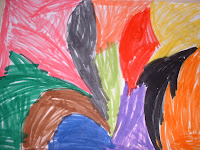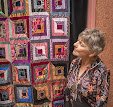 While we were on holiday, Alice beguiled a wet day by creating two patterns which, she thought I could make into quilts. I made the first one into this cushion.
While we were on holiday, Alice beguiled a wet day by creating two patterns which, she thought I could make into quilts. I made the first one into this cushion. 
I photocopied it in monochrome and enlarged it to A3 size.
I marked the outline of each shape using a medium black felt pen and identified the colour on each one.
 Then I traced each shape on tracing paper and cut it out. I used the tracing paper shapes as patterns to cut out the shapes in fabric.
Then I traced each shape on tracing paper and cut it out. I used the tracing paper shapes as patterns to cut out the shapes in fabric.

I marked the outline of each shape using a medium black felt pen and identified the colour on each one.
 Then I traced each shape on tracing paper and cut it out. I used the tracing paper shapes as patterns to cut out the shapes in fabric.
Then I traced each shape on tracing paper and cut it out. I used the tracing paper shapes as patterns to cut out the shapes in fabric.
I sprayed a piece of calico fabric with temporary fabric adhesive and laid out and pinned the pieces on it. Next, the panel was mounted on wadding and backing and pinned through all three layers. Finally, each shape was outlined with a wide zig-zag stitch which had the effect of anchoring the pattern together and at the same time quilting it. A border was added to make a good-sized cushion.




